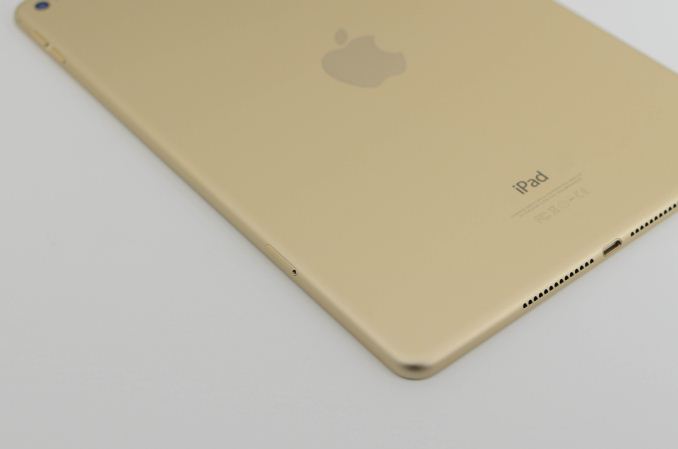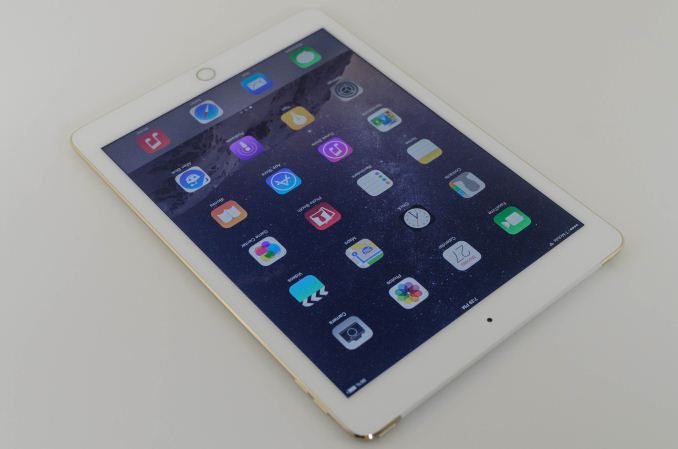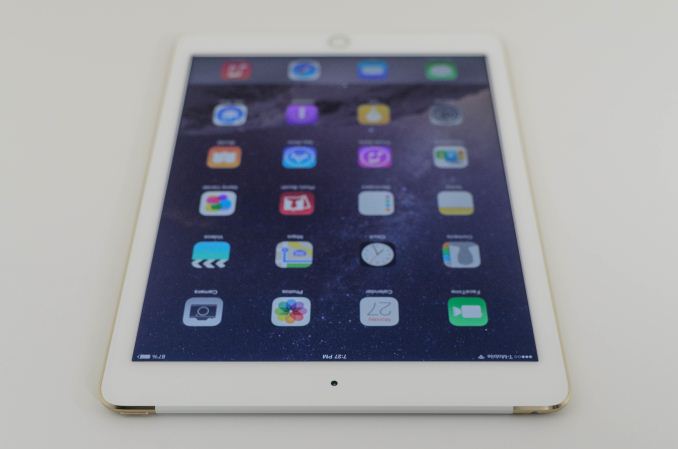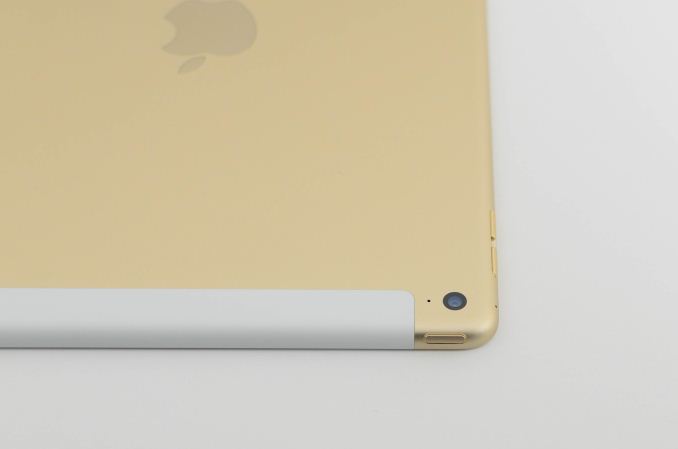The Apple iPad Air 2 Review
by Joshua Ho on November 7, 2014 9:30 AM EST- Posted in
- Tablets
- Apple
- Mobile
- iOS
- ipad Air 2
Final Words
Overall, there’s a lot to go over on the iPad Air 2. While the name suggests that it’s an iterative update in nature, in practice these updates add a lot of compelling hardware to the high-end iPad line. One of the first areas worth looking at here is the design. While not a radical shift from the iPad Air, the differences in design and the even thinner build helps to set the iPad Air 2 apart.
The next item of note is the A8X, which represents a return to dedicated SoCs for the iPad line. This is presumably done to preserve performance parity at native resolution for the iPhone and iPad line, and the extra CPU core is intriguing as it represents a shift away from the two CPU core system that Apple has stuck with for a while. In practice, this makes the iPad Air 2 one of the fastest ARM-based tablets on the market. Only NVIDIA’s Tegra K1 is able to compete with its GPU performance, and at the cost of greater heat and power consumption.
The next major point of note is the display. While not much has changed to the display itself, the surrounding components have seen a few upgrades that have been sorely needed for the past few years. The display is now laminated to the cover lens, which dramatically improves interactions with the device as the display feels much closer to the glass than before. The iPad Air 2 also has a custom anti-reflective coating on the display is really unlike anything else I’ve seen before as the frequencies reflected make the glass appear to be producing purple reflections. Despite keeping the tablet at 200 nits, I found that it was still fully possible to read the display outdoors during the day. There also seems to be some level of improved calibration, although the panel is mostly the same when judged by the appearance of the gamut and also the brightness/contrast numbers. At any rate, this display is more than capable of doing proper photo editing as the device is more than accurate enough for serious work.
Despite these upgrades and the smaller battery, in practice it seems that Apple has made good on their promise of generally unchanged battery life from the iPad Air. While there are phones and phablets out there with better battery life, I suspect that most will be more than happy with the battery life of the iPad Air 2. If one found battery life to be sufficient on a previous iPad, battery life on the iPad Air 2 should just be more of the same rather than any surprises. Apple also deserves some level of recognition for the incredible efficiency and sustained performance during this test as even the Tegra K1 can't quite do both.
There’s also the question of software, which continues to be class-leading on the iPad. While tablet applications that haven’t been properly scaled on the iPhone line are likely to look horrible due to the scaling factor used, this kind of experience is unlikely to occur due to the strength of the ecosystem at this point. While the same can and does happen with Android apps, it isn’t nearly as obvious because most of the scaling done is far more seamless and simply leaves a great deal of white space in the application that can’t necessarily be used.
As a result of all this work, it seems pretty obvious that the iPad Air 2 continues to deliver some of the best tablet software on the market. For the most part, every application available seems to effectively deliver a tablet-specific experience that helps to set the iPad lineup apart from other tablets. Unfortunately, it seems that due to a lack of competition there isn’t much in the way of attempts to dramatically improve the software experience, and as a result it’s a bit difficult for me to justify carrying a tablet around all the time as its size means I can't just put it in a pocket unlike a six-inch phablet.
However, there are still some notable new features, namely TouchID, which works incredibly well and leverages Apple’s tightly-meshed ecosystem to deliver a better experience than just about anything else on the market. Unfortunately, I’m not necessarily sold on TouchID on a tablet as an ergonomic ideal as the sheer width of the device makes it a bit harder than usual to properly place my finger for scanning. The functionality makes up for it though and TouchID remains one of the real killer features of Apple devices.
Finally, the camera is a nice step up from the iPad Air. While it may seem like an incremental step, a meaningful camera change to the iPad Air 2 is relatively surprising given that it hasn’t significantly changed since the iPad 3. It’s surprisingly competent in daytime, although at night a great deal more noise creeps in than one might expect from an iPhone 6 or similar device which has a larger sensor.
Overall, the iPad Air 2 is likely to be one of the only tablets worth buying on the market today. While iOS isn’t perfect, it’s definitely delivering the best tablet experience as its app support is second to none. While other OEMs may have more features, iOS manages to hold on by virtue of its superior polish and integration with Apple hardware. While I’d like to see Apple push the envelope further with the iPad line, it’s hard to argue this when other OEMs seem to be content with the status quo. While it’s likely that Apple will be able to hold on to its tablet lead, it remains to be seen if Google’s Nexus 9 can prove to be a viable competitor to the iPad Air 2.














226 Comments
View All Comments
Sushisamurai - Friday, November 7, 2014 - link
I know right? It's actually really annoying, it's practically forced me to prop it up when using it for TV/movies because holding a vibrating tablet for 40 minutes was a huge pain the in the ass. I'd rather they keep the same size as the iPad Air 1, and just give me 2-4 more hours of use time (by keeping the battery size the same, increased efficiency of A8X) and NO VIBRATING tablet.Sushisamurai - Friday, November 7, 2014 - link
No, my iPad Air 2 does not reproduce this issue, even with full strength one finger push (erred on the side of not bending my iPad). However, I do have a hard plastic back case (thin) on it - applying pressure to the screen also does not produce any issues.Georges003 - Saturday, November 8, 2014 - link
I am apparently not the only one who has noticed this effect on the Air 2. See:http://www.consumerreports.org/cro/news/2014/10/ha...
http://forums.macrumors.com/showthread.php?t=18089...
hammer256 - Friday, November 7, 2014 - link
I recall it was said that Nvidia was not going to use the TSMC 20nm because it's only really ready for SoC production, perhaps because the yield is not good enough for large dies yet? But if the 20nm process can already produce chips with 3 billion transistors at presumably acceptable yield, that is well into the GPU transistor count territory.I just wonder if this holds any indication/promise that Nvidia and AMD could move to 20nm in a relatively quick time frame, say within the next year. 28nm is really getting long in the tooth. Well, at least I imagine Nvidia's next SoC should be on 20nm...
rUmX - Friday, November 7, 2014 - link
It's about volume and Apple bought most if not all of it.kron123456789 - Friday, November 7, 2014 - link
We'll see in 2 months, at CES 2015))It should be the beast)mabellon - Friday, November 7, 2014 - link
Great article Joshua,I was a little disappointed that there was no comparison against the Surface Pro 3. I am not interested in any OS/fanboy wars by any means - purely a hardware comparison. The Geekbench scores for the iPad Air 2 are (1798/4468) as shown in your article. The Geekbench scores for the entry level 1.5Ghz Core i3 Surface Pro 3 are (1569/3137) on a $280 CPU! But that's only one benchmark of course. GPU is certainly a very different beast all together as well.
I would love to see some comprehensive testing to compare ARM (especially the A8X, and 64bit K1) against Intel's offerings. The slower clocked Celerons and Core i3s are the most comparable as those laptops are closer to tablet pricing. The Core M series is coming and its clocked even slower (but has turbo) -it's fanless performance remains to be seen. Ultimately the question is... how close is ARM to truly competing with Intel in the laptop space?
And some food for thought... If a 1.5Ghz A8X is already in striking distance of Intel's low end 1.5Ghz... what would happen if Apple added turbo/higher clocks and a fan?
Impulses - Friday, November 7, 2014 - link
It's all very interesting from a technical curiosity standpoint, but until mobile OS evolve a lot more there aren't gonna be very many people cross shopping anything running iOS (or Android) vs a Surface Pro... And no one wants a Windows system running ARM hardware cause it defeats the point of running Windows.I guess the one exception to all that would be if Apple were working on OS X ARM edition...
mabellon - Friday, November 7, 2014 - link
Agreed. Very much an intellectual curiosity. Windows on ARM defeats the purpose of running Windows. Mobile OSes are not capable of fully replacing a desktop environment for productivity.Apple *could* push out an OSX ARM edition. It would be very interesting to see if they have the clout to get devs on board such a port. Maybe? Maybe it just pushes Intel to improve.
The only ARM product likely to matter in the short term for laptop compete is the Chromebook. Still not feature competitive, but if performance really is encroaching on Intel and price is cheaper, it will at least force Intel to compete on price/perf on the low end.
Aside: I also remembered AT's Surface Pro 3 review with the Core i3. Google Octane 11,600 vs 9,400 gives Intel the edge but the gap is closing fast.
kron123456789 - Friday, November 7, 2014 - link
iOS is OS X ARM ediition, lol.